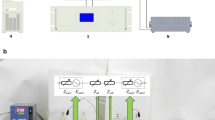Abstract
Salt content and soluble solid content are important test indicators of quality in pickled products according to commercial standards. Pickled cucumber contains many organic compounds and free ions, and its juice, acting as the secondary coil under alternating magnetic flux, shows specific electrical characteristics during pickling. This study applied a detection system based on the o-core transformer to determine the NaCl content (N c ) and soluble solid content (SSC) of pickled cucumber in the extreme low-frequency range of 50 to 400 Hz at room temperature. It is interesting to note that the changes in electrical properties during pickling resulted in impedance changes in the coils of cucumber juice. Results showed that the terminal voltage (U s ) in the secondary circuit was positively correlated with NaCl content and SSC, due to the increase of conductivity in the coil. The inductive current was the ratio of the inductive voltage to the total impedance in the secondary circuit, which increased according to Ohm’s law, resulting in an increase of terminal voltages (U s ) related to the physicochemical properties of the samples, particularly the amount of free ions. The λ value was found to be more effective than U s in evaluating the NaCl content (N c ), while the most effective regression model for predicting SSC was obtained at a primary voltage of 30 V and a frequency of 120 Hz based on U s value. The proposed method laid the foundation to investigate the response characteristics of food materials by combing magnetic flux with transformer properties.




Similar content being viewed by others
References
AOAC. (1995). Official methods of analysis (16th ed.). Arlington: Association of Official Analytical Chemists.
Caricchi, F., Crescimbini, F., Honorati, O., Bianco, G. L., & Santini, E. (1998). Performance of coreless-winding axial-flux permanent-magnet generator with power output at 400 Hz, 3000 r/min. IEEE Transactions on Industry Applications, 34(6), 1263–1269.
Chevalier, D., Ossart, F., & Ghommidh, C. (2006). Development of a non-destructive salt and moisture measurement method in salmon (Salmo salar) fillets using impedance technology. Food Control, 17(5), 342–347.
Etchells, J. L., Bell, T. A., Costilow, R. N., Hood, C. E., & Anderson, T. E. (1973). Influence of temperature and humidity on microbial, enzymatic, and physical changes of stored, pickling cucumbers. Applied Microbiology, 26(6), 943–950.
Falone, S., Mirabilio, A., Carbone, M. C., Zimmitti, V., Di Loreto, S., Mariggiò, M. A., et al. (2008). Chronic exposure to 50 Hz magnetic fields causes a significant weakening of antioxidant defence systems in aged rat brain. The International Journal of Biochemistry & Cell Biology, 40(12), 2762–2770.
Heathcote, M. J., & Franklin, D. P. (1998). The J & P transformer book: a practical technology of the power transformer (12th ed.). Oxford: Newnes.
Hewlett-Packard Inc. (1992). HP Dielectric materials measurements, solutions catalog of fixtures and software: complete solutions for dielectric materials measurements. Application note.
Hewlett-Packard Inc. (2006). Solutions for measuring permittivity and permeability with LCR meters and impedance analyzers. Application note, 1369-1.
James, R. W. (1993). Practical osmosis in vegetable pickling. Journal of Biological Education, 27(2), 90–91.
Kandala, C. V. K., & Nelson, S. O. (2005). Nondestructive moisture determination in small samples of peanuts by RF impedance measurement. Transactions of ASAE, 48(2), 715–718.
Karásková, P., Fuentes, A., Fernández-Segovia, I., Alcañiz, M., Masot, R., & Barat, J. M. (2011). Development of a low-cost non-destructive system for measuring moisture and salt content in smoked fish products. Procedia Food Science, 1, 1195–1201.
Kim, S. S., Kim, N. D., Berkeley, B. H., You, B. H., Nam, H., Park, J. H., et al. (2007). 18.1: Distinguished paper: novel TFT-LCD technology for motion blur reduction using 120 Hz driving with McFi. SID Symposium Digest of Technical Papers, 38(1), 1003–1006.
Kulkarni, S. V., & Khaparde, S. A. (2012). Transformer engineering design, technology, and diagnostics (2nd ed.). Boca Raton: CRC Press.
Masot, R., Alcañiz, M., Fuentes, A., Schmidt, F. C., Barat, J. M., Gil, L., et al. (2010). Design of a low-cost non-destructive system for punctual measurements of salt levels in food products using impedance spectroscopy. Sensors and Actuators, A: Physical, 158(2), 217–223.
Nelson, S. O., Trabelsi, S., & Kays, S. J. (2006). Dielectric spectroscopy of honeydew melons from 10 MHz to 1.8 GHz for quality sensing. Transactions of the ASABE, 49(6), 1977–1981.
Pierzynowska-Korniak, G., & Żywica, R. (2004). Changes in electric properties of apple juice concentrate as a function of selected quality factors. Polish Journal of Food and Nutrition Sciences, 13(3), 255–259.
Pierzynowska-Korniak, G., Żywica, R., & Wójcik, J. (2003). Electric properties of apple purée and pulpy apple juices. European Food Research and Technology, 216(5), 385–389.
Pryor, R. W. (2013). Inductive conductivity measurement of seawater. Boston: COMSOL Conference.
Ryynänen, S. (1995). The electromagnetic properties of food materials: a review of the basic principles. Journal of Food Engineering, 26(4), 409–429.
Slaughter, D. C., Barrett, D., & Boersig, M. (1996). Nondestructive determination of soluble solids in tomatoes using near infrared spectroscopy. Journal of Food Science, 61(4), 695–697.
Thompson, R. L., Fleming, H. P., & Monroe, R. J. (1979). Effects of storage conditions on firmness of brined cucumbers. Journal of Food Science, 44(3), 843–846.
Von Ellenrieder, N., Andrade-Valença, L. P., Dubeau, F., & Gotman, J. (2012). Automatic detection of fast oscillations (40–200 Hz) in scalp EEG recordings. Clinical Neurophysiology, 123(4), 670–680.
Yoo, K. M., Hwang, I. K., Eog, G., & Moon, B. (2006). Effects of salts and preheating temperature of brine on the texture of pickled cucumbers. Journal of Food Science, 71(2), C97–C101.
Żywica, R., Pierzynowska-Korniak, G., & Wójcik, J. (2005). Application of food products electrical model parameters for evaluation of apple purée dilution. Journal of Food Engineering, 67(4), 413–418.
Author information
Authors and Affiliations
Corresponding author
Rights and permissions
About this article
Cite this article
Jin, Y., Yang, N., Ma, Q. et al. The Salt and Soluble Solid Content Evaluation of Pickled Cucumbers Based on Inductive Methodology. Food Bioprocess Technol 8, 749–757 (2015). https://doi.org/10.1007/s11947-014-1439-y
Received:
Accepted:
Published:
Issue Date:
DOI: https://doi.org/10.1007/s11947-014-1439-y




